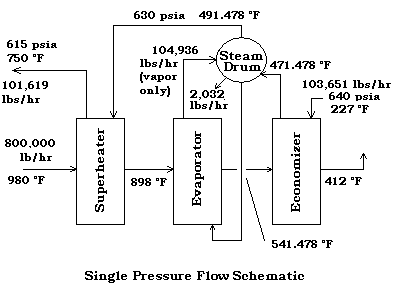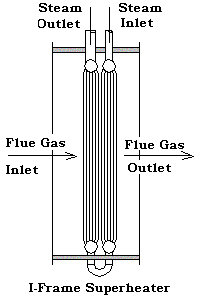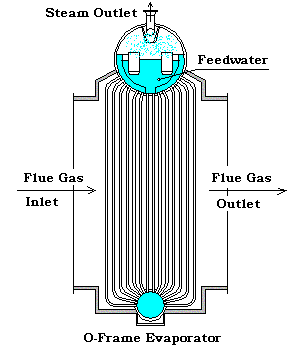Tube material and selection
Selecting the tube material and size to use in a HRSG design is really a matter of experience. As you work with different HRSG's for different services, you develop a knowledge of what fit before in a similar design, so you know where to start with a new design. But a few general rules can be used to start the selection.
For the typical, general purpose HRSG, using standard tubing sizes, the 2" tube size will normally work out to be the most economical tube size. The cost will generally go up with a smaller or larger tube size. Most HRSG units recover heat from a relatively low temperature gas, i.e., less than 1,000 °F. Of course, many of the modern HRSG's are supplementary fired to achieve even greater efficiencies. But, with the exception of the superheater, you can normally assume that carbon steel tubes will work for the evaporator and the economizer. If the superheater outlet temperatures are low, such as 600 °F and below, you should be able to assume carbon steel tubes to start. If higher than 600 °F, you may want to start with T11 tubes.
In a similar manner, you can make some preliminary estimates to determine what the design metal temperature for the HRSG tubes need to be. With this temperature, you would select the least material that is good for the temperature. Eventual analysis may show that a higher alloy and a thinner wall may be more economical, so running calculations with several materials is always wise.
Typical generic, pipe and tube specifications used for HRSG tubes:| Generic Specification | Pipe Specification | Tube Specification |
| Carbon Steel | SA 106 Gr B | SA 178 A |
| 1¼ Cr ½ Mo | SA 335 Gr P11 | SA 213 T11 |
| 2¼ Cr 1 Mo | SA 335 Gr P22 | SA 213 T22 |
| 5 Cr ½ Mo | SA 335 Gr P5 | SA 213 T5 |
| 9 Cr 1 Mo | SA 335 Gr P9 | SA 213 T9 |
| 18 Cr 8 Ni | SA 312 TP 304 | SA 213 TP 304 |
| 16 Cr 12 Ni 2 Mo | SA 312 TP 316 | SA 213 TP 316 |
| 18 Cr 10 Ni Ti | SA 312 TP 321 | SA 213 TP 321 |
| 18 Cr 10 Ni Ti | SA 312 TP 321H | SA 213 TP 321H |
And other, more exotic materials for special services are used as may be needed. The wall thickness required, for the heat absorbing tubes, is calculated by using the ASME Section 1. For heat absorbing tubes, there are two formulas that may apply, so it is normal practice to check the required thickness and maximum allowed working pressure, MAWP, using both formulas, then using the more appropriate.
Tube Wall Thickness:Using ASME, Section 1, PG 27.2.1
And using ASME, Section 1, PG 27.2.1
Where,
| t = Minimum required thickness, in |
| P = Maximum allowable working pressure, psia |
| D = Outside diameter of cylinder, in |
| S1 = Maximum allowable stress value (PG-23), psi |
| S2 = Maximum allowable stress value (PG-23), psi |
| e = Thickness factor for expanded tube ends |
| y = Temperature coefficient |
| E = efficiency |
| C = Minumum allowance for threading and structural stability, in |
Using the above stress values and formulas, we can now calculate the minimum wall thickness for a tube.
In the above tube wall thickness calculator, only the "Tube Specifications", such as SA-178 Gr. A, are being used for stress values, so this calculator is not valid if using a "Pipe Specification", such as SA-106 Gr. B, since the stress values are different. A little bit of confusion over why a pipe is called a tube, when it is in a HRSG, might be expected. But usage dictates that the heat transfer tubes be referred to as tubes regardless of whether they are manufactured from materials specified as tubes or as pipes. If the use is as a downcomer or riser, etc., it is called a "pipe".
When using tubes with the OD of a standard pipe size or using piping specifications and the HRSG uses returns, you would normally select a standard return bend to return the flow to the next tube. These returns bends are normally manufactured in two turning radii, called "short radius" and "long radius". The short radius return refers to a 180° return bend using a radius of one nominal diameter, ie, a 4" pipe size return has a radius of 4", and a 6" has a radius of 6", etc. The "long" radius bend has a radius equal to 1.5 nominal diameters so a 4" return has a radius of 6" and a 6" has a radius of 9". These standard returns are manufactured in most of the pipe schedules and are also available in "minimum wall" specifications.
Typical generic and pipe specifications used for return bends:| Generic Specification | Pipe Specification |
| Carbon Steel | SA 234 WPB |
| 1¼ Cr ½ Mo | SA 234 WP11 |
| 2¼ Cr 1 Mo | SA 234 WP22 |
| 5 Cr ½ Mo | SA 234 WP5 |
| 9 Cr 1 Mo | SA 234 WP9 |
| 18 Cr 8 Ni | SA 403 WP304 |
| 16 Cr 12 Ni 2 Mo | SA 403 WP316 |
| 18 Cr 10 Ni Ti | SA 403 WP321 |
| 18 Cr 10 Ni Ti | SA 403 WP321H |
If using standard pipe fittings manufactured to standard pipe schedules, you would assume 80% of the standard wall thickness. If you are bending tubes or pipe for the application, you would need to calculate the thinning in the bend. The following calculator estimates the ratio of that thinning.
Pipe-Wall Thinning In Bends:Tube Length Selection
Now that we have selected a tube diameter, material, wall thickness, and tube spacing, we need to decide what length the tubes should be. Pipe and tubes are manufactured in random lengths, ie, since the billet size varies, the actual length of the tube that is extruded, from a billet, varies from one tube to the next. For lower cost materials, it is usually cheaper to scrap pieces of tube, then it is to make center welds to try and use all the material. But another high cost factor involved with the length is the supports and guides for the tube in the HRSG.
For vertical tubes, usually the overall HRSG shape and size dictate the best tube length. It is necessary to consider the maximaum shipping width and length in setting the tube length. The support and guide requirement varies depending on whether the tubes are supported from the top(hung) or bottom of the tubes.
In the horizontal tube HRSG's, the overall shape and size also figure into the equation. But, within these constraints, the span between supports must be considered. If the user has not specified a maximum span, then generally you would not want to exceed 35 tube OD's. This has been a general industry "not to exceed" rule of thumb used for many HRSG designs. But care should be taken to consider the service and wall temperature of the tubes. Once you have determined the span between supports, the tube length would be selected to use the minimum number of supports, while avoiding unnecessary centerwelds, if centerwelds are allowed by user. All of this must be balanced with the fact that the pressure loss in the tubes is increased dramatically in the returns, so generally you want the longest straight tube possible. The pressure loss in the returns is reviewed in the "Process" section , under "Intube Pressure Drop".
Now, using the single pressure HRSG that we demonstrated in developing the heat balance in Section 4, we can select the heat transfer tubes necessary to proceed with the thermal design. We are going to select an HRSG unit using 2.000" od tubes, so the following selections will be based on this tube od.
 |
For the superheater, we can assume that the tube wall temperature will be above 750 °F and less than 850 °F, so we will use the 850°F for the design temperature. We will select for our HRSG design, the O-Frame evaporator. So for the superheater we could use a Vertical Tube or an I-Frame type. We will choose the I-Frame.
 |
This design can use either bent tubes, i.e., three rows per bundle, or two straight tubes in a bundle. For this sample, we decide we want three rows per bundle using an 8" pipe header, then we we will decide that the bend radius of the bend in the first and third rows is 6". Using a design pressure of 700 psia, we can check to see if a standard 0.120" minimum wall thickness will be sufficient for this design. Using our bend thinning calculator, we see that the wall thickness after bending will be 0.1013". Then using the tube wall thickness calculator, we see that using the PG 27.2.1 method, that with our 1/32" corrosion allowance, the tube thickness is okay. |
Now, we look at our evaporator, the O-Frame design that we selected above.
 |
Okay, here again we have bent tubes. We will assume that the bend radius of these tubes is 12", so the wall thickness using 0.120" to start with, will be 0.1091" after bending. Using SA 178 Gr A tubes, we check the required wall thickness and find that this tube will be fine. Note that setting the design temperature below 700° F really doesn't have any affect on the PG 27.3.1 calculation, since this formula requires a minimum of 700 °F for the stress value selection. When we check the required wall, we get 0.1102 if we use a 1/32" corrosion allowance. but since no corrosion allowance was indicated, we will use this tube. |
For our economizer, we will use the I-Frame design, but use two tubes per bundle with 6" pipe headers, so we will once again need bent tubes, using a 6" bend radius. This results in a 0.1013" wall thickness at the bends. For this economizer, the 0.120' wall thickness will be okay without corrosion allowance.
Disclaimer:
The formulas and correlations presented herein are all in the public domain and are to be used only as a learning tool. Note that any product, process, or technology in this document may be the subject of other intellectual property rights reserved by sponsors or contributors to this site. This publication is provided as is, without any warranty of any kind, either expressed or implied, including, but not limited to, the implied warranties of fitness for a particular purpose, or non-infringement.
The formulas, correlations, and methods presented herein should not be considered as being recommended by or used by the sponsors of this site. The purpose of this site is educational and the methods may or may not be suitable for actual design of equipment. Only a fired heater design engineer is qualified to decide if a calculation or procedure is correct for an application.